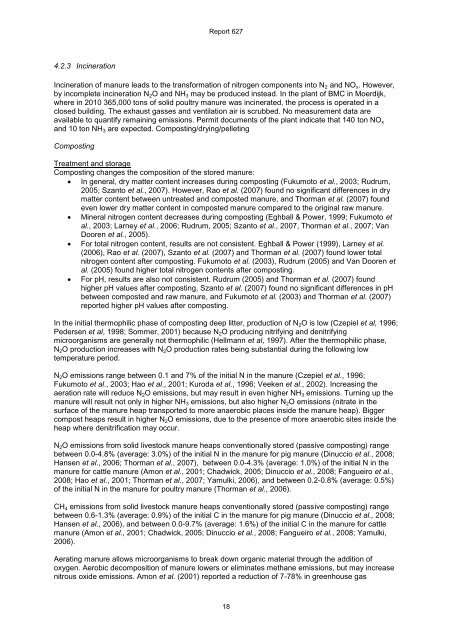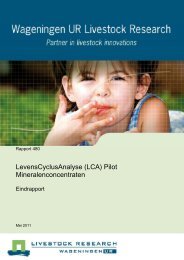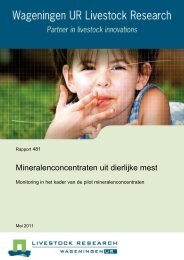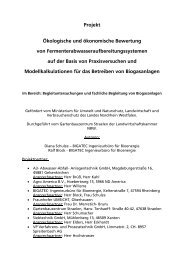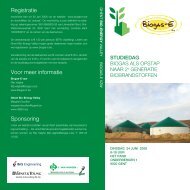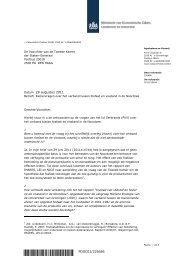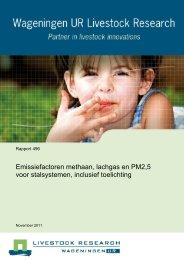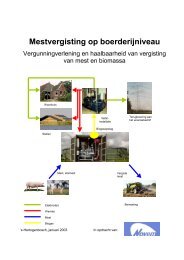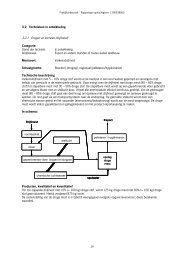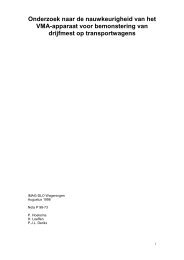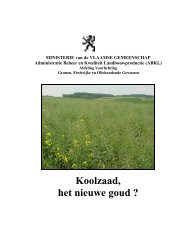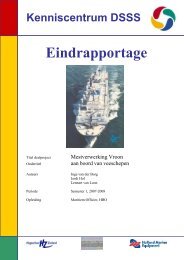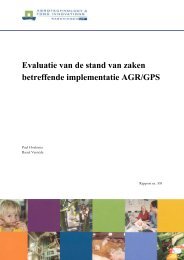Monitoring methane and nitrous oxide reduction by manure treatment
Monitoring methane and nitrous oxide reduction by manure treatment
Monitoring methane and nitrous oxide reduction by manure treatment
You also want an ePaper? Increase the reach of your titles
YUMPU automatically turns print PDFs into web optimized ePapers that Google loves.
4.2.3 Incineration<br />
Report 627<br />
Incineration of <strong>manure</strong> leads to the transformation of nitrogen components into N2 <strong>and</strong> NOx. However,<br />
<strong>by</strong> incomplete incineration N2O <strong>and</strong> NH3 may be produced instead. In the plant of BMC in Moerdijk,<br />
where in 2010 365,000 tons of solid poultry <strong>manure</strong> was incinerated, the process is operated in a<br />
closed building. The exhaust gasses <strong>and</strong> ventilation air is scrubbed. No measurement data are<br />
available to quantify remaining emissions. Permit documents of the plant indicate that 140 ton NOx<br />
<strong>and</strong> 10 ton NH3 are expected. Composting/drying/pelleting<br />
Composting<br />
Treatment <strong>and</strong> storage<br />
Composting changes the composition of the stored <strong>manure</strong>:<br />
In general, dry matter content increases during composting (Fukumoto et al., 2003; Rudrum,<br />
2005; Szanto et al., 2007). However, Rao et al. (2007) found no significant differences in dry<br />
matter content between untreated <strong>and</strong> composted <strong>manure</strong>, <strong>and</strong> Thorman et al. (2007) found<br />
even lower dry matter content in composted <strong>manure</strong> compared to the original raw <strong>manure</strong>.<br />
Mineral nitrogen content decreases during composting (Eghball & Power, 1999; Fukumoto et<br />
al., 2003; Larney et al., 2006; Rudrum, 2005; Szanto et al., 2007, Thorman et al., 2007; Van<br />
Dooren et al., 2005).<br />
For total nitrogen content, results are not consistent. Eghball & Power (1999), Larney et al.<br />
(2006), Rao et al. (2007), Szanto et al. (2007) <strong>and</strong> Thorman et al. (2007) found lower total<br />
nitrogen content after composting. Fukumoto et al. (2003), Rudrum (2005) <strong>and</strong> Van Dooren et<br />
al. (2005) found higher total nitrogen contents after composting.<br />
For pH, results are also not consistent. Rudrum (2005) <strong>and</strong> Thorman et al. (2007) found<br />
higher pH values after composting, Szanto et al. (2007) found no significant differences in pH<br />
between composted <strong>and</strong> raw <strong>manure</strong>, <strong>and</strong> Fukumoto et al. (2003) <strong>and</strong> Thorman et al. (2007)<br />
reported higher pH values after composting.<br />
In the initial thermophilic phase of composting deep litter, production of N2O is low (Czepiel et al, 1996;<br />
Pedersen et al, 1998; Sommer, 2001) because N2O producing nitrifying <strong>and</strong> denitrifying<br />
microorganisms are generally not thermophilic (Hellmann et al, 1997). After the thermophilic phase,<br />
N2O production increases with N2O production rates being substantial during the following low<br />
temperature period.<br />
N2O emissions range between 0.1 <strong>and</strong> 7% of the initial N in the <strong>manure</strong> (Czepiel et al., 1996;<br />
Fukumoto et al., 2003; Hao et al., 2001; Kuroda et al., 1996; Veeken et al., 2002). Increasing the<br />
aeration rate will reduce N2O emissions, but may result in even higher NH3 emissions. Turning up the<br />
<strong>manure</strong> will result not only in higher NH3 emissions, but also higher N2O emissions (nitrate in the<br />
surface of the <strong>manure</strong> heap transported to more anaerobic places inside the <strong>manure</strong> heap). Bigger<br />
compost heaps result in higher N2O emissions, due to the presence of more anaerobic sites inside the<br />
heap where denitrification may occur.<br />
N2O emissions from solid livestock <strong>manure</strong> heaps conventionally stored (passive composting) range<br />
between 0.0-4.8% (average: 3.0%) of the initial N in the <strong>manure</strong> for pig <strong>manure</strong> (Dinuccio et al., 2008;<br />
Hansen et al., 2006; Thorman et al., 2007), between 0.0-4.3% (average: 1.0%) of the initial N in the<br />
<strong>manure</strong> for cattle <strong>manure</strong> (Amon et al., 2001; Chadwick, 2005; Dinuccio et al., 2008; Fangueiro et al.,<br />
2008; Hao et al., 2001; Thorman et al., 2007; Yamulki, 2006), <strong>and</strong> between 0.2-0.8% (average: 0.5%)<br />
of the initial N in the <strong>manure</strong> for poultry <strong>manure</strong> (Thorman et al., 2006).<br />
CH4 emissions from solid livestock <strong>manure</strong> heaps conventionally stored (passive composting) range<br />
between 0.6-1.3% (average: 0.9%) of the initial C in the <strong>manure</strong> for pig <strong>manure</strong> (Dinuccio et al., 2008;<br />
Hansen et al., 2006), <strong>and</strong> between 0.0-9.7% (average: 1.6%) of the initial C in the <strong>manure</strong> for cattle<br />
<strong>manure</strong> (Amon et al., 2001; Chadwick, 2005; Dinuccio et al., 2008; Fangueiro et al., 2008; Yamulki,<br />
2006).<br />
Aerating <strong>manure</strong> allows microorganisms to break down organic material through the addition of<br />
oxygen. Aerobic decomposition of <strong>manure</strong> lowers or eliminates <strong>methane</strong> emissions, but may increase<br />
<strong>nitrous</strong> <strong>oxide</strong> emissions. Amon et al. (2001) reported a <strong>reduction</strong> of 7-78% in greenhouse gas<br />
18


